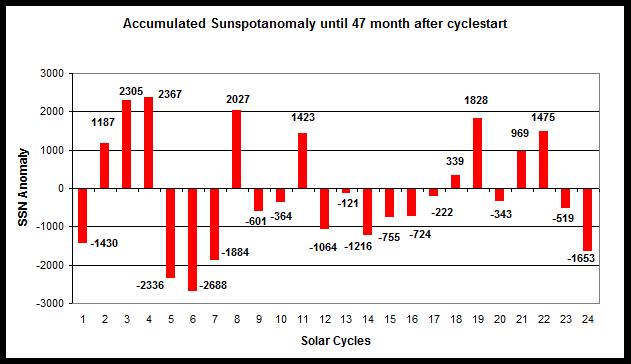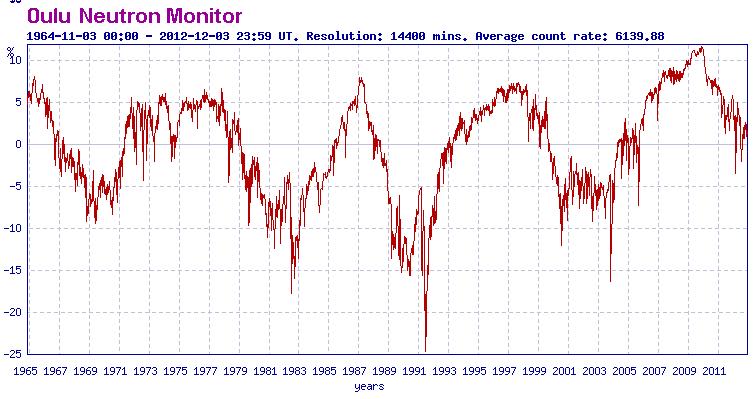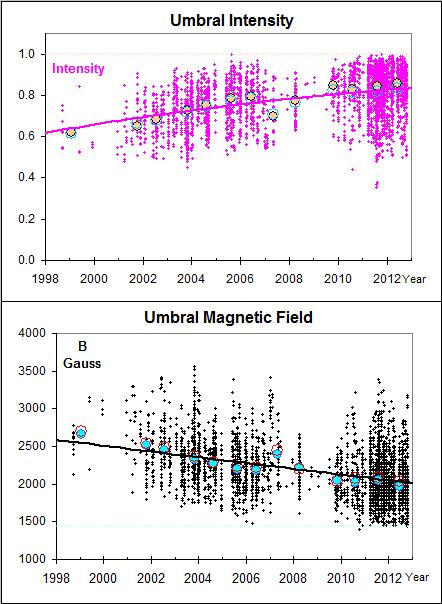Joe Bastardi at weatherbell.com/ posted a video where he tells us that another brutal December is in the works for the Northern Hemisphere.
Meteorologist Joe Bastardi. Photo source: Weatherbell
Contrary to what a few crackpot physicists tell us, it’s not because of a relatively small 2 million sq km area of less ice in September, but because of gigantic areas in the tropical Pacific.
At the 2:10 mark Joe tells us:
What goes on in the tropical Pacific is huge. It’s absolutely huge – you have to understand that. In fact it’s huge as to control the entire climate of the globe, which is why you hear me with the type of attitude I have on that because of the flip of the Pacific to a colder mode.”
Later in the video at the 5-minute mark his attention is directed at Europe:
“Look at this! This is just hard to believe. I just want too, again, people get a little nervous when I start talking about the climate aspect of this, but this is how the Little Ice Age began. In Europe there was an attack of one cold winter after another. This is the fourth one in a row that severe to record-breaking cold has entered Europe.”
Clearly ocean cycles do play a major role on climate, as Joe shows. But it’s not only Europe’s weather that is beginning to resemble the Little Ice Age. Also the sun is beginning to look like it did during the Little Ice Age.
Solar cycles as well bode very ill for the coming winters.
Frank Bosse has an article today at Die kalte Sonne.de/7191 on the current solar cycle. He writes as follows (translated and condensed):
Solar Cycle 24 is indeed the start of a deep solar slumber. Leif Svalgaard published a paper Svalgaard et al. 2005 already back in 2005 where he estimated sunspot activity would be a maximum of 70 for Cycle 24. David Hathaway of NASA and his colleagues on the other hand projected a powerful solar cycle, based of course on a new model. Lesson here: Don’t believe every model.
How has SC 24 progressed thus far?

The red line in the chart above shows the monthly sunspot value. The blue line shows the average of the previous cycles 1-24. The light, thin line depicts the entry into the Minimum of 1800 – 1833 ( SC5…SC7). In November 2012 the sun also was only able to reach half of the average value. All SSN values were corrected according to a new paper by Svalgaard.
The following figure shows a comparison of the periods of activity and allows us to evaluate the accumulated monthly sunspot anomaly for each cycle:

Solar activity as measured by sunspot count today is the weakest we’ve seen since SC 7, which ended in October 1833. The question today is: Was the peak in November 2011 with a SSN=96.7 the high for the current cycle? Although the sun is capable of surprises, all observations indicate that SC 24 indeed reached its peak last year. There are a number of signs that tell us this: The poles of the sun’s magnetic field have switched, which is a strong indicator that the peak is behind us:

The weakness of SC 24 is also indicated by the strength of the solar winds, given by the Ap Index, and is depicted by the following chart:

Here we see that the maximum of the solar wind is always offset by 2-4 years after the sunspot maximum. In 2008 we saw a low point of the kind we haven’t seen since the space age began over 50 years ago. We are still stuck at low levels.
Let’s recall that there are a number of papers showing a strong correlation between low solar activity and harsh winters in Europe, e.g. Lockwood et al.
So what impact could the solar winds have on the planet? They could act as a modulator for cloud formation, which in turn has a massive impact on global temperature – Svensmark’s theory. The following chart depicts the galactic cosmic radiation measured by the Oulu <neutron Monitor, Finland:

It’s easy to see that this curve is the inverse of solar activity: the weaker the solar winds, the greater the cloud-seeding cosmic rays reaching the Earth’s atmosphere. In the current cycle, cosmic radiation is 5-15% stronger than the previous cycle.
So what do the experts say? Much points to a Grand Minimum. observation of the convection belt, solar corona and magnetic field strength of the solar sunspots allows us to derive that the sun could get a lot weaker. This last occurred during the Maunder Minimum from 1645-1715. Scientists Livingston and Penn were hardly given attention when they had observed in 2005 there had been a good linear falling tendency since 2000 with regards to magnetic field and sunspots.

If this development continues, then we will see hardly any activity during solar cycle 25, which is anticipated to begin in 2020. It could very well be that our quiet sun is a harbinger of what is to come in the years and decades ahead.
Models of the mainstream climate scientists say: It will not impact the climate on Earth more than 0.1 to 0.2°C. Such models may very well be wrong – much like the “solar model” in 2006 projected a powerful SC 24.






The SC5/SC24 comparison graph does not appear to be corrected. Today we count sunspots differently compared to the 1800’s. For a better comparison there is always the Layman’s Sunspot Count.
http://www.landscheidt.info/images/sc5_sc24.png
The sunspot count in your first graph may well be too high, due to improved instrumentation picking up more small spots. Geoff Sharp‘s corrected number has SC24 tracking below SC5.
For further coverage of the some of these main points my post Global Cooling – Climate and Weather forecasting on my blog at http://climatesense.norpag.blogspot.com
In Australia, South of the Tropic of Capricorn, December is the first month of summer. Officially.
So there’s no surprise that temperatures in the national capital fell to near-freezing overnight.
http://www.smh.com.au/environment/weather/coldest-december-morning-on-record-20121206-2awjz.html
————–
The mercury in Canberra plummeted to 0.3 of a degree overnight – the coldest December minimum on record.
The unseasonably chilly temperature was recorded at 5.44am, and by 6.45am the mercury was still only sitting at four degrees.
A duty forecaster from the Canberra office of the Bureau of Meteorology said the minimum this morning was the coldest Canberra has experienced in 75 years of records.
—————
But that’s not climate change; it’s “air-change”.
Unfortunately, just about all the politicians had already fled the capital after the close of parliamentary sessions for the year.
This is all very interesting but except for the ‘cosmic ray – cloud formation’ connection there is not a mechanism that explains what is going on. Joe B’s comment of “because of the flip of the Pacific to a colder mode” is not an explanation. I wonder if he is speaking of the PDO? In the past he has mischaracterized the PDO as a temperature issue rather than a pattern. It is also for a part of the Pacific O. and not the “tropical Pacific” mentioned in the 2:10 mark paragraph quoted. The ENSO is the ‘elephant in the room’ as regards the Pacific O. and its effects are felt world wide. What seems still unknown is why the Trade Winds come and go.
I’m just being skeptical. I don’t know what is going on. I look at the graphs and agree there are some interesting things being suggested. The physical science to support the claims is not here – yet.
The idea that open water in the Arctic Ocean allows more cooling than ice covered water is intriguing. It makes sense that colder air there will eventually come to lower latitudes. I am surprised that folks are not complaining about the deliberate breaking up of the ice as it refreezes.
http://www.bbc.co.uk/news/science-environment-20454757
“Built in 2007 with a strengthened hull, the Ob River can carry up to 150,000 cubic metres of gas. The tanker was loaded with LNG at Hammerfest in the north of Norway on 7 November and set sail across the Barents Sea. It has been accompanied by a Russian nuclear-powered icebreaker for much of its voyage.”
There’s certainly a clear correlation between solar cycles and global temperature cycles. Therefore there has to be an amplification mechanism.
John, look at the Dr. Lüning interview here. He mentions another highly variable phenomenon, namely, the intensity of UV radiation in the solar spectrum, lagging behind the solar cycle. As IR can’t warm the ocean but UV can, I think this might be part of the mechanism.
http://www.youtube.com/watch?feature=player_embedded&v=1kdxxbSmUwQ
We can be sure of one thing: The ruling warmists in Germany will make sure that as we are hit by one winter colder than another, energy and electricity cost will rise 15 % each year, and they will continue to demand we send billions to the UN or to some countries suffering from a global warming that ceased to exist in 1998.
And every time we call them out for their lies they’ll point to the IPCC as their scientific authority and call us anti-scientific.
I wonder how well offshore wind turbines stay vertical in an ice field.
Only warm weather is evidence of dangerous climate change – cold weather is just weather.
[…] Brutal Cold Headed For Europe And North America – Solar And … Go to this article […]
[…] Read More: notrickszone.com […]
Any chance of a link to the video – damned if I can find it on Joe’s site.
This went missing a day ago, so I’ll try again.
Pierre and Dirk
Basically I agree with the idea that there must be Sun-related mechanisms and (+/-) amplifications that influence the short term climatic shifts (not writing of Milankovitch here). I think the data presented by Bob Tisdale on ocean warming and cooling should encourage research on connections between solar energy and the Trade Winds.
We fairly well know the energy in the Sun’s spectrum and that the shortwave radiation (& UV) enters and warms a massive area of ocean water. It is not a great leap of insight to think that warming of that water varies with clouds insofar as anyone having flown above thick clouds can attest to their high reflectivity. UV and cloud interaction is more complex. It is also known that the trade winds and the clouds vary over short and longish times. (I don’t like the term ‘cycles’ as it implies a regularity about these things that isn’t in the data.)
If I were allocating research money, a lot of effort would go toward trying to understand the solar inputs and the workings of the atmosphere that control those inputs to the Equatorial/Tropical oceans. I think we would have an answer by now if half the money spent on CO2 research over the last 30 years had, instead, been focused on the ocean and the solar inputs.
[…] “Look at this! This is just hard to believe. I just want too, again, people get a little nervous when I start talking about the climate aspect of this, but this is how the Little Ice Age began. In Europe there was an attack of one cold winter after another. This is the fourth one in a row that severe to record-breaking cold has entered Europe.” Meteorologist Joe Bastardi. […]
[…] Brutal Cold Headed For Europe And North America – Solar And Ocean Cycles Bode Of An Approachin… (notrickszone.com) […]